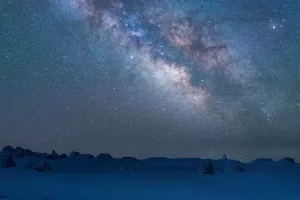In the Martian night sky, serpent-like auroral belts could spread thousands of kilometers. According to the latest observations from the Emirates Mars Mission (EMM), this is a beautiful night view of the aurora, a bizarre aurora phenomenon that has never been seen on any planet.
Typically Earth's auroras occur at the South or the North Pole and occur when charged particles from the solar wind collide with molecules in the planet's atmosphere.
Several different types of auroras have been observed on Mars, including: "diffuse auroras", which glow faintly across the Martian sky during intense solar storms; and "discrete aurora", which occur sporadically. They only occur above areas of potentially magnetized minerals in the Martian crust.
The formation of the meandering discrete auroras remains a mystery, a shocking discovery with some speculative ideas but a lack of reliable evidence.
The newly discovered martian aurora phenomenon is called "spinning discrete auroras" and is likely to be a strange hybrid of other auroras. The aurora occurred during a recent solar storm when charged particles swept through Mars' thin atmosphere.
As these charged particles rise along the atmospheric magnetic field lines, elongated tendrils of light meander across the sky from Mars' day side to its night side, covering half the Earth's diameter.
How did the "luminous phenomenon" appear in the Martian night sky, an invisible light?
Like Earth, Mars also has days and nights. Earth rotates 24 hours a week, and Mars rotates 34 hours and 37 minutes, so a Martian day is much longer than an Earth day, and a Martian night is much longer than an Earth night.
On August 5, 2020, a new study published in the Journal of Geophysical Research found that when the blue sun sets, a glow appears over the dark side of Mars. It's an invisible light that can only be viewed with special equipment.
At other times of a Martian year, such as winter, the polar regions also show a bright glow. The winter solstice is the most intense and forms unexpected shapes, waves, and spirals.
Unfortunately, the makeup of the Martian atmosphere means this glowing phenomenon does not emit light in visible wavelengths, making it impossible for future astronauts to live on Mars to see them with the naked eye, except with scientific instruments.


